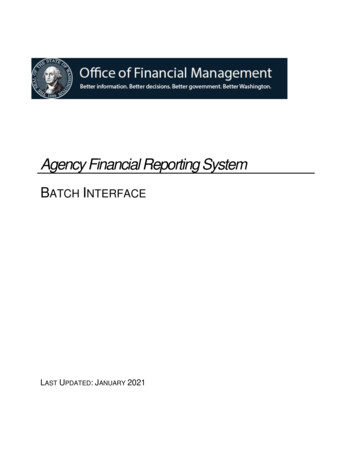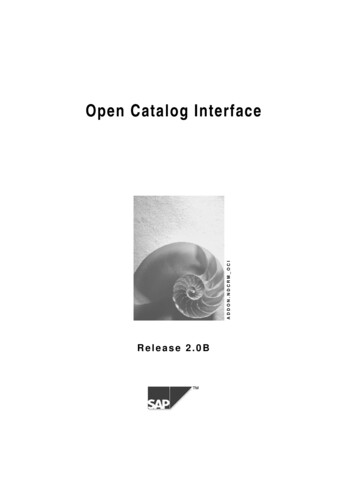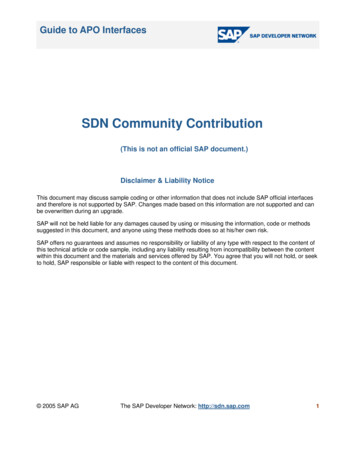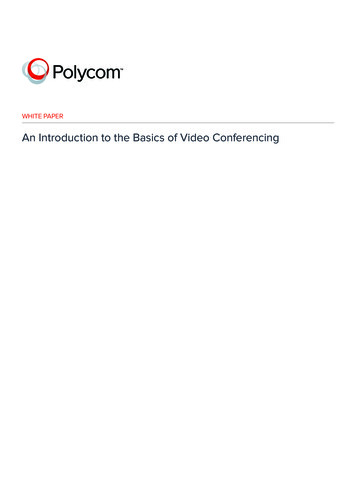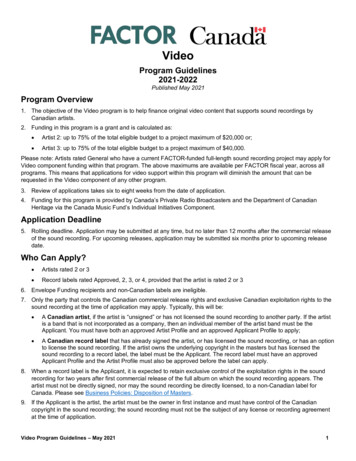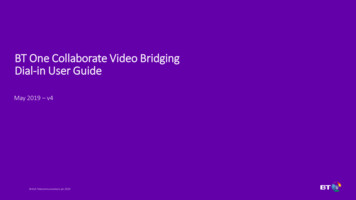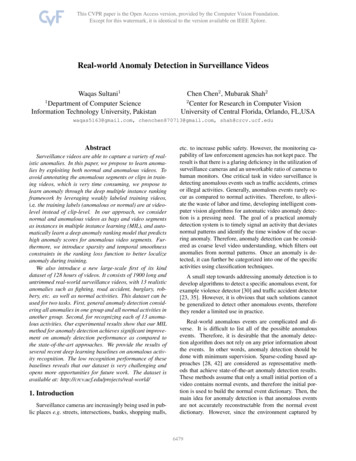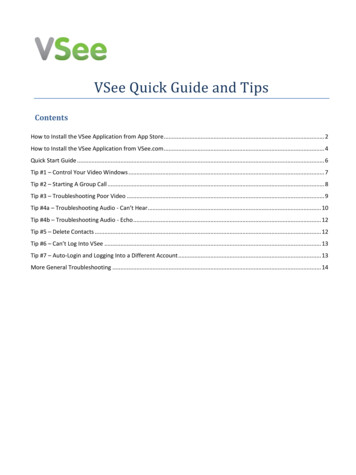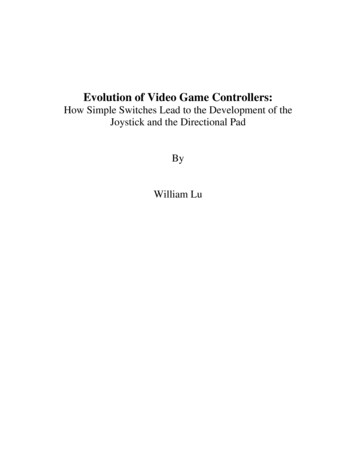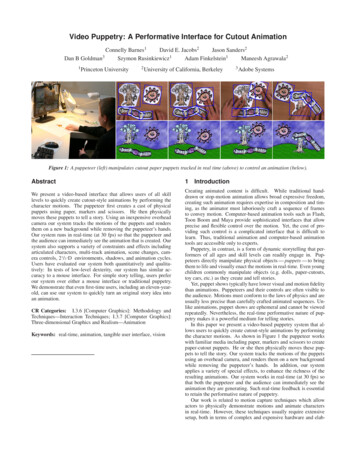
Transcription
Video Puppetry: A Performative Interface for Cutout AnimationDan B1Goldman3Connelly Barnes1David E. Jacobs2Jason Sanders21Szymon RusinkiewiczAdam Finkelstein1Maneesh Agrawala2Princeton University2University of California, Berkeley3Adobe SystemsFigure 1: A puppeteer (left) manipulates cutout paper puppets tracked in real time (above) to control an animation (below).AbstractWe present a video-based interface that allows users of all skilllevels to quickly create cutout-style animations by performing thecharacter motions. The puppeteer first creates a cast of physicalpuppets using paper, markers and scissors. He then physicallymoves these puppets to tell a story. Using an inexpensive overheadcamera our system tracks the motions of the puppets and rendersthem on a new background while removing the puppeteer’s hands.Our system runs in real-time (at 30 fps) so that the puppeteer andthe audience can immediately see the animation that is created. Oursystem also supports a variety of constraints and effects includingarticulated characters, multi-track animation, scene changes, camera controls, 2 1/2 -D environments, shadows, and animation cycles.Users have evaluated our system both quantitatively and qualitatively: In tests of low-level dexterity, our system has similar accuracy to a mouse interface. For simple story telling, users preferour system over either a mouse interface or traditional puppetry.We demonstrate that even first-time users, including an eleven-yearold, can use our system to quickly turn an original story idea intoan animation.CR Categories: I.3.6 [Computer Graphics]: Methodology andTechniques—Interaction Techniques; I.3.7 [Computer Graphics]:Three-dimensional Graphics and Realism—AnimationKeywords: real-time, animation, tangible user interface, vision1 IntroductionCreating animated content is difficult. While traditional handdrawn or stop-motion animation allows broad expressive freedom,creating such animation requires expertise in composition and timing, as the animator must laboriously craft a sequence of framesto convey motion. Computer-based animation tools such as Flash,Toon Boom and Maya provide sophisticated interfaces that allowprecise and flexible control over the motion. Yet, the cost of providing such control is a complicated interface that is difficult tolearn. Thus, traditional animation and computer-based animationtools are accessible only to experts.Puppetry, in contrast, is a form of dynamic storytelling that performers of all ages and skill levels can readily engage in. Puppeteers directly manipulate physical objects — puppets — to bringthem to life and visually enact the motions in real-time. Even youngchildren commonly manipulate objects (e.g. dolls, paper-cutouts,toy cars, etc.) as they create and tell stories.Yet, puppet shows typically have lower visual and motion fidelitythan animations. Puppeteers and their controls are often visible tothe audience. Motions must conform to the laws of physics and areusually less precise than carefully crafted animated sequences. Unlike animations, puppet shows are ephemeral and cannot be viewedrepeatedly. Nevertheless, the real-time performative nature of puppetry makes it a powerful medium for telling stories.In this paper we present a video-based puppetry system that allows users to quickly create cutout-style animations by performingthe character motions. As shown in Figure 1 the puppeteer workswith familiar media including paper, markers and scissors to createpaper-cutout puppets. He or she then physically moves these puppets to tell the story. Our system tracks the motions of the puppetsusing an overhead camera, and renders them on a new backgroundwhile removing the puppeteer’s hands. In addition, our systemapplies a variety of special effects, to enhance the richness of theresulting animations. Our system works in real-time (at 30 fps) sothat both the puppeteer and the audience can immediately see theanimation they are generating. Such real-time feedback is essentialto retain the performative nature of puppetry.Our work is related to motion capture techniques which allowactors to physically demonstrate motions and animate charactersin real-time. However, these techniques usually require extensivesetup, both in terms of complex and expensive hardware and elab-
orate character rigging. More recently enthusiasts have used gameengines to create animated content called machinima. Games offerreal-time feedback and their controls are designed to be very easyto learn. However, users are limited to working with pre-designedenvironments and characters with a narrow range of motions. Thus,this approach significantly limits freedom of expression.The primary contribution of our work is the interface for creating animated stories via the performance-based direct manipulationparadigm of puppetry. This interface is designed to present a shallow learning curve to users of all skill levels, while placing as fewlimits as possible on creativity in the design of characters, paintingof backgrounds, and telling of stories. Our camera-based input isinexpensive, using hardware that many users already own. Moreover, the effects possible with our system are difficult to achievewith systems such as stop-motion animation or traditional puppetry.Although the resulting animations cannot match the visual qualityof a studio production, they are suitable in many contexts, including kids’ productions, animatics, or the class of animations such as“South Park” or “JibJab” that explicitly target a “cutout” aesthetic.We describe an initial study in which we evaluate our systemin three ways. First, in a low-level task measuring motor skills,we compare our system against a mouse-based interface and findno significant difference in accuracy. Second, in a mid-level task,users tell a specific story using three different tools — our system,a mouse interface, and traditional puppetry — and evaluate whichmethod they prefer. In this test, all users preferred our system.Third, at a higher level, users draw their own characters and telltheir own stories. Our results indicate that even first-time users,including an eleven-year-old, can use our system to quickly turn astory idea into an animation.2Related WorkDeveloping an interactive and easy-to-learn interface that people ofall skill levels can use to create animation is a long-standing problem in computer graphics. Here we focus on interface techniquesthat go beyond standard GUI-based solutions.Sketch-based animation: Many systems allow users to create animatable objects and demonstrate their motions via sketching [Baecker 1969; Moscovich and Hughes 2001; Davis et al.2008]. However, while drawing 2D translational motion paths iseasy, even simple 2D rotations and scales can be difficult to sketch.Moreover, these systems only allow one object to move at a timeand therefore require multiple record-and-playback cycles to builda multi-object layered animation.Several systems explore techniques for sketching articulated figures and their motions. Moscovich and Hughes [2001] describean IK-based layered animation control system in which users select multiple joints to control different layers of motion. Thorne etal. [2004] develop a gestural interface in which users are limited toworking with a library of pre-defined motions. Davis et al. [2003]provide an interface for converting 2D drawings of skeletal keyposes into 3D articulated figure animations. Since users must drawthe keyposes this system is not demonstration-based.Another approach is to combine sketching with simulation techniques. Alvarado and Davis [2001] use physics-based mechanicalsimulation, while LaViola and Zeleznik [2004] use general mathequations to animate sketches. Popović et al. [2003] allow users todraw motion paths for 3D objects and then run rigid-body simulations to compute physically plausible motion that best matches thesketch. While these techniques can generate high-quality motion,the user must give up some control over the resulting animation.Performance animation: Motion capture systems are designedto interactively transfer an actor’s physical performance to a virtualcharacter. Computer puppetry [Sturman 1998] is another form ofperformance animation in which the performer uses a specializedinput device such as an articulated armature [Knep et al. 1995]to control the character in real-time. Both Oore et al. [2002] andDontcheva et al. [2003] have developed interfaces for quickly creating and editing layered character animations using either motioncapture or tracked props. Despite their ease of use, however, thesetechniques are out of reach for most users because they requireexpensive specialized hardware. Moreover, using these systemsrequires some expertise in building animatable 3D characters andspecifying the mapping between the motions of the actor or inputdevice and those of the character.Video-based animation: In some cases it is much faster to capture video of a real scene than it is to create an animation of thescene. Yet, real-world video does not have the same visual character as most animation. One way to resolve this problem is toapply non-realistic video rendering techniques [Wang et al. 2004;Winnemöller et al. 2006; Bousseau et al. 2007] on the input video.With more sophisticated video processing, such as optical flow calculation or object tracking, it is possible to add non-photorealisticmotion cues such as deformations and streak lines to the video [Collomosse and Hall 2005; Collomosse and Hall 2006; Wang et al.2006]. However, none of these techniques can change the visualcontent of the video – they only modify its visual style. If theuser’s hand is in the input video it remains in the output animation. Video cutout [Wang et al. 2005] and user-guided rotoscopingmethods [Agarwala 2002; Agarwala et al. 2004] can address thisproblem as they provide more control over the composition of theoutput video. Yet, these techniques do not work in real-time andtherefore cannot be part of a performance-based interface.Tangible and multi-touch interfaces: Our work is inspired bytangible and multi-touch interfaces. Tangible interfaces [Ishii andUllmer 1997] allow users to manipulate physical objects to control the computer. These interfaces usually allow coordinated twohanded input and provide immediate visual feedback about the position of the physical objects. In our system the tangible paperpuppets act as the physical interface objects. Moreover, paper isa familiar material with well-known affordances, so most users areimmediately aware of the kinds of puppets they can create and thekinds of motions they can perform.Recently Igarashi et al. [2005] have shown that direct multitouch control is a natural interface for controlling non-rigid deformable characters. Although our paper-based system similarlyallows such multi-touch control over the puppets, it also assumesthe paper puppets are rigid or articulated models and cannot generate non-rigid animations. Nevertheless, because users of oursystem work with physical puppets, they benefit from kinestheticfeedback about the position and orientation of the puppets, andcan lift puppets off the table to control scale and depth orderingusing a more natural affordance than a multi-touch device can provide. Moreover, the table-top and camera interface offers severalother benefits relative to multi-touch, such as ease of selection ofoff-screen characters and components, the ability to scale to large(multi-performer) workspaces, and the relative ubiquity and lowcost of cameras.Video-based paper tracking: Several systems have been designed to recognize and connect physical paper documents andphotographs with their electronic counterparts [Wellner 1993; Rusand deSantis 1997; Kim et al. 2004; Wilson 2005]. These techniques use video cameras to capture the movements of the physicaldocuments and track the position and stack structures of these documents. Users can then choose to work with the tangible physicaldocument or the virtual copy. Our system applies similar ideas andtechniques to the domain of real-time animation authoring.Augmented reality: The field of augmented reality has pioneeredapplications that combine camera-based input, low-level trackingand recognition techniques similar to those we use, and computer-
Puppet BuilderOur puppet builder provides an intuitive interface for adding newpuppets to our system. A user first draws a character on paper withmarkers, crayons, or other high-contrast media. Next the user cutsout the puppet and places it under the video camera. The puppetbuilder captures an image of the workspace and processes the imagein several stages before adding the puppet to a puppet database. Fornon-articulated puppets, the processing is automatic and takes about15 seconds per puppet. We describe the puppet building process forarticulated characters in Section 6.1.In the first stage of processing the puppet builder recovers twomattes for the puppet (Figure 2). The paper matte, used duringtracking, includes the entire piece of paper containing the puppet,while the character matte, used for overlap detection and rendering,includes only the region containing the character. To generate thepaper matte we perform background subtraction on the input frameand apply a flood-fill seeded from a corner to isolate the paperboundary. We then fill the background with white and performa second flood-fill to obtain the character matte. This TransformsOcclusionDetection/ResolutionKLT Path (Real-Time)GPU-KLTTrackingKLT PointAssignmentSystem OverviewOur video-based puppetry system is divided into two modules; apuppet builder and a puppet theater. From a user’s perspective thefirst step in creating an animation is to construct the cast of physical puppets. The puppet builder module then captures an image ofeach puppet using an overhead video camera and adds it to a puppetdatabase (Section 4). Then as the user manipulates the puppets toperform a story, the puppet theater module tracks the puppet movements and renders them into an animation in real-time.Internally, the puppet theater module consists of a tracker, an interpreter, and a renderer. The input to the theater module is a videostream of the puppet movements. The tracker computes a mappingbetween the puppets in each video frame and their correspondingimages in the puppet database, as well as a depth ordering betweenoverlapping puppets (Section 5). The interpreter then applies constraints on the tracked transforms and detects non-actor puppets thattrigger special rendering effects (Section 6). Finally, the rendererdisplays the output animation.4SIFT FeatureExtractionTransform and Depth Order Per Puppet3SIFT Update Path (Not Real-Time)Input Framegenerated rendering. Indeed, our system falls in the under-explored“augmented virtuality” zone of Milgram’s continuum [1994], anddemonstrates a novel application in this area: animated storytelling.In contrast with some augmented reality systems, however, we explicitly focus on tracking unmodified paper puppets, as created bynovice users. In particular, we do not use visually-coded tags foridentification, as is done by some previous systems [Rekimoto andAyatsuka 2000; Fiala 2005; Lee et al. 2005]. While the use of suchtags would simplify tracking and recognition, it would impose unwanted additional burden on users: they would have to generate thetags, attach them to the physical puppets, and register the mappingbetween the tags and the puppets in the tracking system.Figure 3: An overview of our tracker. The tracking path (bottom) iscomputed in real time on each frame, while the identification path(top) is computed as a background task.is based on the assumptions that the puppet is evenly illuminatedand that the character boundary is defined by an edge that contrastssharply against the white paper background.One consequence of our approach is that correct mattes are extracted only for characters of genus zero. Although other automated methods such as color range selection could allow for highergenus puppets, these techniques could not distinguish holes fromintentionally-white regions in the puppet, such as eyes. Therefore,a user can only produce higher-genus mattes using an image editor.In the second stage, the puppet builder generates data structuresthat will be used by the real-time puppet theater module to recognize puppets, track them, and detect overlaps.5 Puppet Theater: TrackerAlthough object tracking is a well-studied topic in computer vision [Trucco and Plakas 2006], our system places two key designrequirements on the tracker. First, it must robustly recognize thewide variety of hand-drawn puppets users may create. Second, itmust accurately track those puppets in real time. As shown in Figure 3, our approach takes advantage of the complementary strengthsof two techniques. SIFT features are used to identify all puppetsevery 7-10 frames. Between SIFT updates, optical flow on KLTfeatures is used to track the movement of puppets in real time.We have found this combination of techniques to be relativelyefficient and robust for the entire tracking pipeline: recognition,frame-to-frame propagation, and depth ordering. We tune it to beconservative in the following sense: it rarely reports incorrect puppet locations, at the cost of greater likelihood of losing tracking.When the tracking is lost, the on screen character simply freezes atits last known position. We have found this to be the most naturalresponse, and users quickly figure out what happened. They thensimply hold the character still until new SIFT features are found(typically within a few frames) and then the character jumps to thecorrect location.5.1 Identifying PuppetsFigure 2: To matte out the puppet from the input frame our systemfirst performs background subtraction. Next it applies a flood-filltechnique to isolate the paper matte and then the character matte.We recognize puppets using the Scale-Invariant Feature Transform,which selects a set of distinctive feature points from an input imageand computes a descriptor based on edge orientation histograms ateach point [Lowe 1999]. As noted by Kim et al. [2004], SIFT descriptors are well-suited for matching and recognition tasks becausethey are invariant under translation, rotation, and scale, robust topartial occlusion and illumination changes, and distinctive.
We compute SIFT features at a subset of video frames, matchingeach extracted feature to the most similar one in our precomputeddatabase. Given a set of features matching to the same puppet, weapply a Hough transform to prune outlier matches. We then useleast-squares minimization to compute a similarity transform thatbest maps the puppet image from the database to the video frame.The main drawback of this approach is its computational cost.Even though we parallelize the feature matching, we are only ableto execute the identification loop every 7-10 frames, dependingon resolution (typically 640 480) and the size of the puppetdatabase.1 Thus, we only use this pathway to initialize puppet transforms and, as described below, to compensate for accumulated driftin our real-time tracking.5.2Figure 4: Left: a puppet annotated with KLT points. Right: whenpuppets overlap, the KLT tracker will often find points along theirmoving boundary. These “phantom” points (yellow) move in arbitrary ways, and are rejected as outliers.Tracking PuppetsOur real-time tracking pathway is based on the Kanade-LucasTomasi (KLT) technique [Tomasi and Kanade 1991], which findscorner-like features and determines their motion using opticalflow.2 We identify tracked features with puppets and maintain puppet transformations as follows.Identifying features: Newly-found KLT features are associatedwith a puppet if and only if they overlap the character matte ofexactly one puppet known to be present. This may occur if we havesuccessfully been tracking the puppet (based on other features), orif we have identified the puppet via the SIFT pathway. Thus, a newpuppet will not be tracked until the identification pathway has run,and must remain motionless for up to 10 frames so that the SIFTposition corresponds to the true position of the puppet. Similarly,if a puppet is moved while completely occluded by other puppetsor the user’s hands, we must wait until it is identified in its newposition. However, if a puppet is occluded but is not moved, thenas soon as it is unoccluded we propagate the puppet’s identity fromits last-observed position, and immediately resume tracking.Tracking features: The motion computed by optical flow is usedto propagate feature identities from frame to frame (Figure 4, left).We leave unassigned any features that overlap one puppet’s papermatte and another puppet’s character matte, since these are likelyto be “phantom” points whose motion does not necessarily matchthe motions of either puppet (Figure 4, right). We use precomputed oriented bounding box (OBB) trees [Gottschalk et al. 1996]to accelerate the point location tests against the character and papermattes (Figure 5).Computing puppet transformations: Given the motion of features that have been assigned to a puppet in two consecutive frames,we use the method of Horn [1986] to solve for translation, rotation,and scale. This is used to update the puppet’s transformation. Anyfeatures not consistent with the recovered transformation are considered outliers, and are marked as unassigned.Compensating for drift: Because the puppet transformations aremaintained by incrementally applying the results of frame-to-frameKLT tracking, they are subject to accumulation of errors (Figure 6).We can eliminate this error by periodically using the SIFT pathway to provide the ground-truth transformation. However, becauseSIFT requires k frames of computation time, we cannot remediatethe error immediately. Instead, we correct the error at frame i kby starting with the newly-obtained ground-truth position for framei, and re-applying all subsequent frame-to-frame transforms. Thiscan result in puppets “popping” into position, but we prefer thisapproach over smoothing with a predictive filter because the SIFTupdates are far more reliable than the KLT updates. By using this12We use Lowe’s implementation to compute the SIFT features:http://www.cs.ubc.ca/ lowe/keypoints/We use the GPU-based KLT implementation by Sinha et al.:http://www.cs.unc.edu/ ssinha/Research/GPU KLT/Figure 5: Leaves of the oriented bounding box trees for the paperand character mattes.Figure 6: Correcting cumulative KLT errors. A SIFT input frame(left) and the current input video frame at the time of SIFT’s completion (right). Blue rectangles show the KLT transforms for thepuppet. The green rectangle shows the SIFT transform for frame iafter k frames of processing time. We concatenate the SIFT transform with the incremental KLT transforms after frame i to producethe combined SIFT and KLT transform (red rectangle). Our systemassumes that this combined transform is more correct than the KLTtransform (blue) for frame i k.scheme, at any given instant the puppet’s pose on the screen is always as accurate as possible given the available information.Withdrawing puppets: As described above, if we are unable tolocate any KLT features belonging to a puppet, we assume that ithas been occluded and keep track of its last known location. An exception is made if the puppet was near the edge of the video frame –in this case, we assume that it was moved off-screen, and withdrawit from our list of active puppets.5.3 Resolving Depth OrderingWhen puppets partially occlude each other our tracker determines adepth ordering among them so that the virtual puppets can be rendered in the proper depth order. We begin by detecting occlusions:we check for overlap between the character matte OBB-trees of all
Figure 7: Articulated puppets add an extra dimension of expressiveness not possible with single-body puppets.pairs of visible puppets, using a 2D version of the separating axistest proposed by Gottschalk et al. [1996].Once we have detected an occlusion, we must determine whichpuppet is frontmost. Although we could compare the image contents in the overlap region to the images of both puppets in thedatabase, this would be neither computationally efficient nor robust.Instead we apply a sequence of tests to determine depth ordering:1. Number of KLT Features. If one puppet owns more KLT features in the region of overlap, it is likely to be on top.2. Relative Scale. A puppet whose image is larger than its initialsize (computed by the puppet builder when it was lying on thetable) is likely to be closer to the camera and thus on top.3. Velocity. It is often difficult to move occluded puppets quickly.Therefore, the faster-moving puppet is likely to be on top.4. Puppet ID. If no other test is conclusive, we arbitrarily considerthe puppet with lower ID to be on top.The tests are ordered by decreasing reliability and therefore weterminate as soon as one is deemed conclusive (based on anexperimentally-determined threshold).To maintain frame-to-frame coherence in depth ordering, we initially transfer all conclusive pairwise relationships from the previous frame to the current frame. Thus, the depth ordering can beflipped only if a more reliable test contradicts the previous result.Given pairwise occlusion information, we perform a topologicalsort to obtain a global depth ordering among the puppets. Althoughthe occlusion graph can contain cycles, in practice these are physically difficult to produce and are rare in normal interaction. Wehave therefore not implemented any complex heuristics for resolving occlusion cycles, simply breaking such cycles greedily.Figure 8: Multi-track animation. Left: the octopus body movements are recorded in a first track. Middle: several of the legsare recorded next, while playing back the first track for reference.Right: after several more layers are added (including a fish character), the final animation.creates a physical analog to inverse kinematics. Yet, articulatedpuppets can also be cumbersome to control — especially whentheir segments are relatively small. Moreover, the large occlusionsbetween pinned segments can make it difficult to accurately trackthe segments and compute their depth ordering.In our video puppetry system there is no need for the segmentsto be pinned together. While users can work with physically connected segments, they can also separate the segments and work withthem independently when more control is needed (Figure 7).Articulated Puppet Builder: We have extended our puppetbuilder module (Section 4) to support articulated puppets. Aftercapturing each segment of an articulated puppet using the standardbuilder, the user specifies the joint positions and depth ordering between pairs of segments using a drag-and-drop interface. As shownin Figure 7 the user drags from the lower segment to the upper segment in the depth ordering. The user then picks a root segmentwhich controls the gross translation for the entire puppet.Articulation Constraints: The tracker independently tracks eachsegment of the articulated puppet. During the interpretation process, we traverse the articulation hierarchy from the root downto the leaves, translating each segment such that its joint locationagrees with that of its parent. Thus, for each segment other thanthe root, only its tracked orientation affects the rendered output.Whenever a segment disappears from the tracker (typically becauseit leaves the working area) it is rendered in a default orientation.With our basic tracking system alone, users can render animationsof rigid puppets on new backgrounds while removing the puppeteer’s hands. We have found that in many cases this is enoughfunctionality to produce an effective animation. However, whenwe combine the raw transforms output by the tracker with an interpretation module, we can take full advantage of our animation toolas a digital system. The special effects and puppetry techniquesmade possible by an interpretation phase expand the user’s creativehorizons without sacrificing ease of use.Depth Ordering: One drawback of working with disconnectedpuppets is that rendered segments may overlap while their physicalcounterparts do not. In such cases, the system must determine aplausible depth ordering. We solve the problem by choosing thetopological sort of the occlusion graph (Section 5.3) that favorsshowing puppets of larger relative scale.Although our approach only works for tree-structured joint hierarchies, we have found it to be sufficient for many types of puppets.Additionally, our approach gives users the flexibility to work withpuppets that are either physically connected or disconnected. Inpractice we have found that disconnected puppets are often easierto manipulate, as they can be arranged in the workspace so that theydo not physically occlude or interact with one another.6.16.2 Multiple animators or tracks6Puppet Theater: InterpreterArticulated PuppetsArticulated puppets, composed of multiple rigid segments, physically pinned together at joints, are common in shadow puppetry andother traditional forms [Wisniewski and Wisniewski 1996]. Whilesuch articulated puppets are more difficult to create than puppetscomposed of a single rigid segment, they offer the possibility ofmuch more expressive motions. Pinning the segments togetherThe control of complex puppets or multiple puppets can be distributed among several puppeteers, each controlling separate props.The puppeteers might share a common work space, or our systemcan combine the tracking data from multiple puppeteers working atseveral identical stations like the one shown in Figure 1, collaborating either in the same room or remotely. Each participant may
Figure 9: Controls and Effects. From left to right: zooming into the scene using “hand” puppets; faux shadows as
like animations, puppet shows are ephemeral and cannot be viewed repeatedly. Nevertheless, the real-time performative nature of pup-petry makes it a powerful medium for telling stories. In this paper we present a video-based puppetry system that al-lows users to quickly create cut
